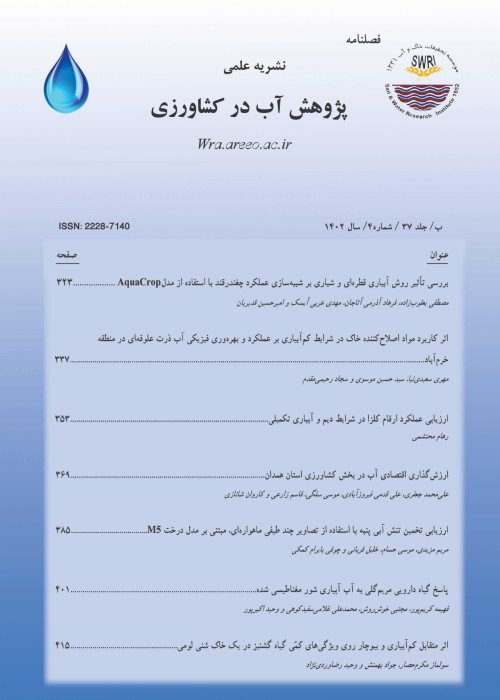Effect of Biochar Obtained from Different Sources on Yield and Water Use Efficiency of Wheat
Author(s):
Article Type:
Research/Original Article (دارای رتبه معتبر)
Abstract:
The use of organic waste in the form of biochar in order to ameliorate soil is a novel approach in the management of organic waste. In previous studies, researchers mostly focused on the amount of biochar that was added to the soil. However, the aim of this study was to investigate the characteristics of biochars prepared from different feedstock (wheat straw, vermicompost and apricot firewood) and the interaction effects of amounts and particle sizes of biochars on yield and water use efficiency (WUE) of winter wheat. In a factorial experiment with a randomized complete block design with three replications, the effects of these three biochars in the amount of 0.5% (R1), 1.5% (R2) and 3% (R3) with a particle size of ≤0.5 (S1), 0.5-1 (S2) and 1-2 (S3) mm were evaluated in two consecutive cropping years. The studied biochar were added to the soil only in the first year to a depth of 0-15 cm. A control plot was considered in each replication. The interactions of experimental factors (except interaction effect of year and biochar amount) on yield and WUE were significant. Comparison of average yield and WUE in each type of biochar showed that, in the first and second year, wheat straw biochar treatment of R3 S2 had the highest yield (5,200 kg ha-1 and 6664.3 kg ha-1, respectively) and WUE (1.6 kg m-3 and 2.1 kg m-3, respectively). In the first year, in vermicompost biochar treatments, the highest yield (4517.7 kg ha-1) and WUE (1.4 kg m-3) were observed in the R2 S3. In the same year, in apricot wood biochar, treatment R3 S3 had the highest yield (3871.7 kg ha-1) and WUE (1.2 kg m-3). In the second year, in vermicompost treatments, the highest yield (6615.7 kg ha-1) and WUE (2.04 kg m-3) was observed in the R3 S2 and, in the same year, in apricot wood biochar treatments, the highest yield (5263.7 kg ha-1) and WUE (1.6 kg m-3) was observed in the R2 S3. The highest yield and WUE (in the two years) was observed in wheat straw biochar with the R3 S2. These results showed that in addition to the type of biochar, the interaction of the amount and size of biochar particles had a decisive effect on increasing the yield and water use efficiency of wheat.
Keywords:
Language:
Persian
Published:
Journal of Water Research in Agriculture, Volume:35 Issue: 4, 2022
Pages:
357 to 371
https://magiran.com/p2408018
دانلود و مطالعه متن این مقاله با یکی از روشهای زیر امکان پذیر است:
اشتراک شخصی
با عضویت و پرداخت آنلاین حق اشتراک یکساله به مبلغ 1,390,000ريال میتوانید 70 عنوان مطلب دانلود کنید!
اشتراک سازمانی
به کتابخانه دانشگاه یا محل کار خود پیشنهاد کنید تا اشتراک سازمانی این پایگاه را برای دسترسی نامحدود همه کاربران به متن مطالب تهیه نمایند!
توجه!
- حق عضویت دریافتی صرف حمایت از نشریات عضو و نگهداری، تکمیل و توسعه مگیران میشود.
- پرداخت حق اشتراک و دانلود مقالات اجازه بازنشر آن در سایر رسانههای چاپی و دیجیتال را به کاربر نمیدهد.
In order to view content subscription is required
Personal subscription
Subscribe magiran.com for 70 € euros via PayPal and download 70 articles during a year.
Organization subscription
Please contact us to subscribe your university or library for unlimited access!



